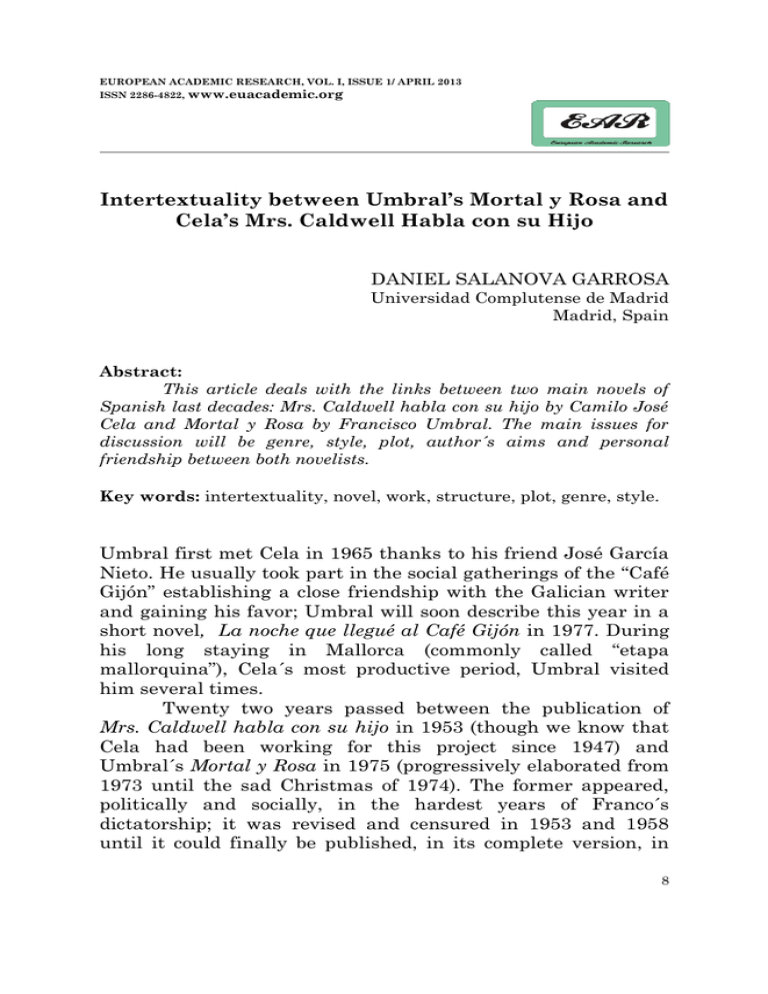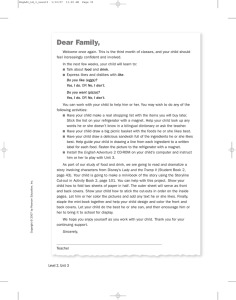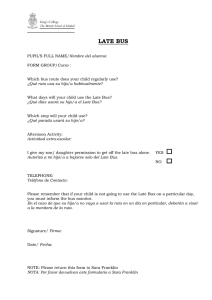Intertextuality between Umbral`s Mortal y Rosa
Anuncio

EUROPEAN ACADEMIC RESEARCH, VOL. I, ISSUE 1/ APRIL 2013 ISSN 2286-4822, www.euacademic.org Intertextuality between Umbral’s Mortal y Rosa and Cela’s Mrs. Caldwell Habla con su Hijo DANIEL SALANOVA GARROSA Universidad Complutense de Madrid Madrid, Spain Abstract: This article deals with the links between two main novels of Spanish last decades: Mrs. Caldwell habla con su hijo by Camilo José Cela and Mortal y Rosa by Francisco Umbral. The main issues for discussion will be genre, style, plot, author´s aims and personal friendship between both novelists. Key words: intertextuality, novel, work, structure, plot, genre, style. Umbral first met Cela in 1965 thanks to his friend José García Nieto. He usually took part in the social gatherings of the “Café Gijón” establishing a close friendship with the Galician writer and gaining his favor; Umbral will soon describe this year in a short novel, La noche que llegué al Café Gijón in 1977. During his long staying in Mallorca (commonly called “etapa mallorquina”), Cela´s most productive period, Umbral visited him several times. Twenty two years passed between the publication of Mrs. Caldwell habla con su hijo in 1953 (though we know that Cela had been working for this project since 1947) and Umbral´s Mortal y Rosa in 1975 (progressively elaborated from 1973 until the sad Christmas of 1974). The former appeared, politically and socially, in the hardest years of Franco´s dictatorship; it was revised and censured in 1953 and 1958 until it could finally be published, in its complete version, in 8 Daniel Salanova Garrosa– Intertextuality between Umbral’s Mortal y Rosa and Cela’s Mrs. Caldwell Habla con su Hijo 1969, by Editorial Destino (Platas Tasende 2004: 100), with Chapter number 204 and the short text, “La cabeza, la geometría y el dragón” having been removed. On the other hand, Mortal y Rosa, originally divided into 41 chapters, each of them accompanied by different sequences, was published during the last period of Franco´s regime; therefore Cela´s novel saw the light of printing during the social novel culmination while Umbral´s one - during the experimental period. Mrs. Caldwell habla con su hijo develops a truly thin argument in which the main character writes a few letters to his son, Eliacim Arrow Caldwell, dead in his youth during a shipwreck near Aegean´s Sea coasts; this constitutes a leitmotif across the whole novel. His mother, cruel, sweet, and chaotic, eventually dying in a mental hospital, by committing suicide, provides the reader with digressions and advice, in a nutshell, biographical sketches, in order to make us discover the incestuous and secret love she felt for her illegitimate son. The author takes us to England, justifying that the Anglo-Saxon world has traditionally been freer than the Spanish one, and because of the subversive elements of the issue (Benoussan, 1974 : 59-64). In this text, Cela is again playing with the narrative technique of the founded manuscript as he used to do before in La familia de Pascual Duarte declaring he had known the main character in Pastrana and confirming that his intention is no other than transcribing the letters he managed to keep with the help of a friend, Sir David Laurel. Mortal y Rosa presents a different thematic orientation. Francisco Umbral Suárez, Pincho, Umbral´s son, was born in the last years of the sixties´ decade; that is why Umbral began his novel in an impulse of putting all his feelings on paper. He once said: “había una verdad en mi vida hijo y eras tú1”. He also wrote a short article “Estoy oyendo crecer a mi hijo”, published during New Year´s Eve in Barcelona in 1971; later on we will find the tale of “La mecedora” ( Martínez Rico 2002: 184-203). The novel will change from a positive point of view, full of joy, seeing his descendant as a perfect reflection of himself, mixed 1 “There was a truth in my life, son, and that was you”. Author´s translation. EUROPEAN ACADEMIC RESEARCH, VOL. I, ISSUE 1/ APRIL 2013 9 Daniel Salanova Garrosa– Intertextuality between Umbral’s Mortal y Rosa and Cela’s Mrs. Caldwell Habla con su Hijo up with digressive issues on various topics, such as, his autobiography, his personal concept of literature, visions of the underground, public toilets up to the middle of the work when he deals with Pincho´s illness, his despair, the author´s burnout and finally the son´s death. Apparently this chaotic thematic does not invite evident comparisons between the two texts. Nevertheless a deeper search will lead us to many surprising aspects in which both novels converge. First of all, in his nearly mathematical prologue, Cela offers us a panoramic view of his previous novels in order to place the reader within the context of this particular piece of writing; written in the second person, it is linked to his digressions about life and literary production, focusing on the importance of the author´s distance to evaluate his work as a whole. In addition to the use of the second person, Umbral will assert: “la literatura es la distancia definitiva que perpetuamos entre nosotros y las cosas” (Umbral 1995: 82), from this perspective the metafictional element becoming the common ground of both novels discussed. Before studying the prologue, the significance of the title, Mortal y Rosa, should be underlined. It is extracted from a verse that Pedro Salinas wrote in one of the poems included in La voz a ti debida: “esta corporeidad mortal y rosa/ donde el amor inventa su infinito”. But the symbolism hidden in “rosa” goes beyond Salinas´ intentions and links the reader with Juan Ramón Jiménez‟s verse - “todas las rosas son la misma rosa” that Umbral rephrases as follows: “todos los niños son el mismo niño” (Umbral 1995: 163). The pair “rosa/niño” could be understood in the same way Cela did with the first part of his memories, “La rosa”, which deals with childhood, while he was writing Mrs. Caldwell habla con su hijo. The most intriguing question while analyzing these texts is determining which the genre they belong to. Leaving apart the different theories that have been proposed for these works, we shall focus on a few ideas that first line critics have formulated about Cela´s novel ( Benoussan 1974: 62 ): EUROPEAN ACADEMIC RESEARCH, VOL. I, ISSUE 1/ APRIL 2013 10 Daniel Salanova Garrosa– Intertextuality between Umbral’s Mortal y Rosa and Cela’s Mrs. Caldwell Habla con su Hijo -Alborg or Torrente Ballester offer a negative point of view affirming that it is not a novel (the latter one labeled it as “terrible mistake”). -Sobejano places it in the company of confession novels, being lyric and conscience examining. -Vilanova classifies it as an epistolary novel. -Ynduráin places it half way between biography and historicism. -Lázaro Montero defines it as surrealist novel. -Pemán considers it as an intimate work. Similarly, we can find different categorizations of Mortal y Rosa; the author himself made several mentions about it as a poem in prose, an intimate diary, even a “bad novel”, in Diario de un snob. Caballé defines Umbral´s novel as a “diary dated between self- portrait and confession” (Caballé 2004: 245, 264). Caballero Bonald states that it is an intimate diary; García Posada - a poem in prose or an atypical novel in the line of Joyce, Broch, or Virginia Woolf. Gómez de la Serna and De Prada (Prada, 1995: 21) understand it as a hybrid constructed of elements of intimate diaries, elegiac poems and fiction novels (Amorós 1977: 6). In addition to all the above mentioned critical receptions, we perceive clear influences of Juan Ramón Jiménez, especially with his Platero y yo, of Marcel Proust or Gabriel Miró because of the slowness of the narrative pace, and, additionally, we should not forget that Unamuno also published a diary when his child was born in 1897. Andrés Amorós pointed to the writer‟s autobiographical tone in conjunction with the search for natural expressiveness, highlighting, additionally, the simplicity of an intimate diary based on the didactical elements correlated with a lyrical level that reminds the reader of classical verses. Theories are served for all tastes but we could conclude that in both novels there is a clear intention of breaking the plot, a wish for uttering monologues to the child (real or fictional), to sum up, an attempt to removing the canonical elements of the novel in order to substitute them by poems in EUROPEAN ACADEMIC RESEARCH, VOL. I, ISSUE 1/ APRIL 2013 11 Daniel Salanova Garrosa– Intertextuality between Umbral’s Mortal y Rosa and Cela’s Mrs. Caldwell Habla con su Hijo prose as, in fact, the presence of short poems in many chapters can also prove. Surrealism can be found as a directing line in the construction of both novels: fragmentary thoughts, association of ideas, words and feelings. Colourful and improvising language, yet with meanings that support each other and fill the novel with sense, represents the modality through which Cela makes us experience the full subjectivity of language. Thus he varies between objectivity and intimacy, as, for example, when under the surface of the real experience he alludes to „realities‟ such as: lack of faith, fish, and dreams… In the same way, Mortal y Rosa modifies the conventional characteristics of prose, in terms of both its writing and perception, Magritte, the surrealist painter, being suggested as kindred. (Ilie 1971: 199 – 208). Mrs. Caldwell´s psychological thoughts are deeply linked to Freud´s ideas while Umbral, from the very beginning, sets himself against the mentioned philosopher. Both characters, the English mother and Umbral, display a „vital pessimism‟ by placing their son as the centre of happiness in their life. The child‟s death, in both cases, functions similarly to Faulkner‟s “singular reference framework”, a central coagulating element, linking everything else around it. Object fetishism is obvious in both works: water, chimney, photography - symbolizing passion in Mrs. Caldwell, while Umbral stops in the silence of the trains (toys), then the blackboards or the scissors used to cut Pincho´s nails. There also appears the image of a rocking chair that fills up with meaning for the couple when it starts being used to put the child into sleep (the first edition of the novel was illustrated with this chair). Photographs are used to provide exchanging flashes of existence between parents and children. There are two chapters which are particularly linked in the two works. Chapter 98 in Mrs.Caldwell habla con su hijo is an allusion to the loss of the maternal instinct replaced with focusing on one´s job. In the same way, in an interview with Martínez Rico, Umbral will defend maternity in terms of verbal aggressiveness nearing to Cela´s words two decades before: EUROPEAN ACADEMIC RESEARCH, VOL. I, ISSUE 1/ APRIL 2013 12 Daniel Salanova Garrosa– Intertextuality between Umbral’s Mortal y Rosa and Cela’s Mrs. Caldwell Habla con su Hijo “Tenéis un hijo y se lo dejáis a la criada o a la abuela y os vais a la oficina a trabajar. Es mucho más apasionante criar a un niño y hablar con él, ver cómo va despertando y como se va abriendo, es mucho más apasionante que estar en una oficina haciendo fotocopias” ( Martínez Rico 2002: 77 ). The other chapter would be number 141, which deals with leisure; according to Cela, leisure is man´s greatest perfection, while Umbral will say that it is the work that dignifies men. In terms of style, there is also a common element that brings the two works. Steiner speaking of the “language animal”, we could apply this expression to Francisco Umbral who, without an apparent desire of genre, builds his novel setting together metaphors, tears, blood and syntax. They both tend to concentrate chapters, what is usually called “page quality”, to use “ritornellos”, lists of mixed up adjectives, anecdotes, inventions, series of adjectives and synesthesia. We would like to finish with Camilo José Cela´s interview in ABC in 1995 where he said: “Los escritores que vivieron literariamente e identificaron vida y literatura han pasado ya a la historia, los últimos fueron Valle – Inclán, Manolo Machado, Ramón Gómez de la Serna y el último que nos queda es Paco”. On the other hand, Umbral published a book full of semblances of Cela and it ended up in the following way (Umbral 2002): “Escribo este epílogo para cerrar mi libro pero no para despedir al amigo recio, secular y fiel que será una presencia en mi memoria literaria y en la otra. Se me ha muerto el profesor de energía. Antes había tenido otros pero ya no tendré más. Un profesor de energía es un verdadero padre. Camilo José fue el padrote ilustrado y veraz de mis penúltimos y mejores tiempos literarios. Alguna vez iré a Padrón a visitarle bajo ese olivo encorpachado donde le enterraron. Un olivo centenario que habiendo vivido un siglo, nos acoge y reúne a los dos. Eso espero”. EUROPEAN ACADEMIC RESEARCH, VOL. I, ISSUE 1/ APRIL 2013 13 Daniel Salanova Garrosa– Intertextuality between Umbral’s Mortal y Rosa and Cela’s Mrs. Caldwell Habla con su Hijo BIBLIOGRAPHY Amorós, A. 1977. “El género de Mortal y rosa y Diario de un snob.” La Estafeta literaria 616: 4-7. Bensoussan, A. 1974. “Camilo José Cela y el incesto en Mrs. Caldwell habla con su hijo.” Actas V Congreso. Caballé, A. 2004. Umbral: el frío de una vida. Madrid: Espasa – Calpe. Cela, C.J.C. 1953. Mrs. Caldwell habla con su hijo. Barcelona: Destino. Ilie, P. 1971. La novelística de Camilo José Cela. Madrid: Gredos. Martínez Rico, E. 2002. La obra narrativa de Francisco Umbral. Tesis doctoral. Dir. Dr. Ignacio Díez Fernández. Madrid: UCM. ______________. 2001. Umbral: vida, obra y pecados. Conversaciones. Madrid: Foca. Platas Tasende, A. 2004. Camilo José Cela. Madrid: Síntesis. Prada, J.M. 1995. “Y la palabra se hizo carne: Mortal y rosa” Ínsula 581: 20-21. Sotelo Vázquez, A. 2003. “Mrs. Caldwell habla con su hijo o la penumbra de una soledad ardiente de deseo.” In Prólogo a Mrs. Calwell habla con su hijo. Barcelona: Destino. Umbral, F. 1995. Mortal y rosa. Edited by Miguel García- Posada. Madrid: Cátedra. __________. 2002. Cela: un cadáver exquisito. Barcelona: Planeta. Zamora Vicente, A. 1962. Camilo José Cela: acercamiento a un escritor. Madrid: Gredos VII- Campo abierto. EUROPEAN ACADEMIC RESEARCH, VOL. I, ISSUE 1/ APRIL 2013 14








